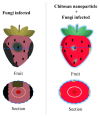Application of Nanocomposites-Based Polymers on Managing Fungal Diseases in Crop Production
- PMID: 40776542
- PMCID: PMC12332492
- DOI: 10.5423/PPJ.RW.02.2025.0029
Application of Nanocomposites-Based Polymers on Managing Fungal Diseases in Crop Production
Abstract
Phytopathogen caused loss of global crop production of 16% and up to 25% in developing countries. Among them, fungi accounted for the highest ratio value with 42%, which direct reduced crop yield and quality. Nanotechnology can be applied to crop protection to build sustainable agricultural production. Polymers (gum, mucilage, chitosan) are naturally derived, readily available, inexpensive, convertible, and biodegradable, which could be combined with nanotechnology to enhance their properties and benefit. In this review, ionic gelation is more popular than nanoprecipitation, emulsion, γ-rays irradiation, and chemical reduction methods in preparing nanocomposites-based polymers in the management of fungal diseases in crop production. The chitosan was often dominated among the polymers. Moreover, the chitosan can be applied as chitosan nanoparticles or combined with an active ingredient (saponin, copper, silver, zinc, titanium dioxide, ethanolic blueberry extract, methanol of nanche extract, Mentha longifolia extract, Cymbopogon martinii essential oil, Harpin, salicylic acid, Thiamine, hexaconazole, dazomet, hexaconazole-dazomet) to enhance their efficacy in managing plant fungal disease. The fungicide, mental, and plant extracts are often loaded into the chitosan matrix to enhance antifungal and/or physical barrier properties. While phytohormones, vitamins, and mental are often used to stimulate plant disease resistance. And chitosan can be used as an adjuvant in metal/oxide mixture. In recent years, other polymers including polyethylene glycol, nanoliposomes, and poly(L-lactide) have been shown remarkable capabilities including resisting water washing and acting as a membrane filter with antifungal properties. These results show that the nanocomposites based-polymer has the ability to effectively manage plant diseases.
Keywords: managing fungal diseases; mode of action; nanocomposites; polymer.
Conflict of interest statement
No potential conflict of interest relevant to this article was reported.
Figures







References
-
- Abdel-Aliem H. A., Gibriel A. Y., Rasmy N. M. H., Sahab A. F., El-Nekeety A. A., Abdel-Wahhab M. A. Antifungal efficacy of chitosan nanoparticles against phytopathogenic fungi and inhibition of zearalenone production by Fusarium graminearum. Commun. Sci. 2019;10:338–345.
-
- Ahmed A., He P., He P., Wu Y., He Y., Munir S. Environmental effect of agriculture-related manufactured nano-objects on soil microbial communities. Environ. Int. 2023;173:107819. - PubMed
-
- Akter J., Jannat R., Hossain M. M., Ahmed J. U., Rubayet M. T. Chitosan for plant growth promotion and disease suppression against anthracnose in chilli. Int. J. Environ. Agric. Biotechnol. 2018;3:806–817.
Publication types
Grants and funding
LinkOut - more resources
Full Text Sources

